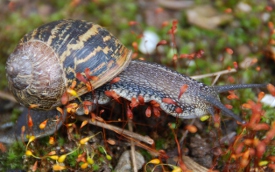Snail Mucus May Alter Plant Defenses
 Predator-prey relationships make up a large part of the food chain, and both predators and prey have developed visual, auditory, physical, and even chemical abilities to better their respective chances for surviving, whether that means catching a meal or avoiding turning into one. Ants may mimic spiders to avoid predators and a grizzly bear’s size and strength allow them to feast on pretty much anything. But what about the interactions between a slow-moving predator, like the garden snail pictured above, and completely stationary “prey,” like a plant?
Predator-prey relationships make up a large part of the food chain, and both predators and prey have developed visual, auditory, physical, and even chemical abilities to better their respective chances for surviving, whether that means catching a meal or avoiding turning into one. Ants may mimic spiders to avoid predators and a grizzly bear’s size and strength allow them to feast on pretty much anything. But what about the interactions between a slow-moving predator, like the garden snail pictured above, and completely stationary “prey,” like a plant?
Garden snails are found throughout the world and feast on many species of plants, including those in our gardens. One of those species is the black mustard plant. Originally from the Mediterranean, black mustard is now common throughout the world. Scientists are working to understand if a common plant, like black mustard, may be able to pick up chemical signals from snail mucus called kairomones and preemptively change their biochemistry to become less appealing to snails. Snails produce mucus during motion, and its presence is often a good indicator to plants that a snail is nearby.
In a recent article published in PLOS ONE, a researcher from the Department of Zoology at the University of Wisconsin-Madison studied whether “unwounded” black mustard plants exposed to snail mucus before being exposed to actual snails experienced lower rates of snail predation.
The researcher exposed black mustard plants at different ages to snail mucus, collected on paper, when the plant was a seed, a seedling, or when it was a seed and again when it was a seedling. The control plant group was not exposed to mucus at any point. After plants were exposed to one of these treatments, a single adult garden snail was then placed with one of the plants to measure if the snail would munch on each plant equally.
Plants that received early exposure or a repeated exposure to mucus during the seedling stage showed a reduced susceptibility to snail feeding or “attack,” but plants in the control group experienced no significant reduction in feeding. The author suggests that plants may pick up on chemicals associated with plant eaters—in this case snail mucus—that may prompt them to become less appealing before an initial attack even occurs.
Although the chemical mechanism that the plants used to make themselves less appealing isn’t clear, in this predator-prey-like interaction, the predators may actually be inadvertently making their dinner less appealing. Turns out gardeners aren’t the only ones that don’t like slimy snail trails.
Citation: Orrock JL (2013) Exposure of Unwounded Plants to Chemical Cues Associated with Herbivores Leads to Exposure-Dependent Changes in Subsequent Herbivore Attack. PLoS ONE 8(11): e79900. doi:10.1371/journal.pone.0079900
Image: Garden Snail by Michael Gwyther-Jones
